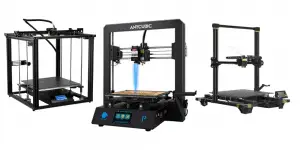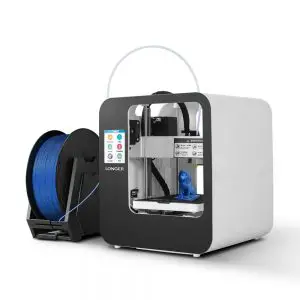The most popular materials for 3D printing are ABS and PLA filaments. With good reason. They both are well suited for an endless number of projects. But they are not the same and have different properties that lend themselves better to some projects over others. One material produces products that are strong and impact resistant. The other produces more smooth aesthetic end results. Which is better for your needs? Let’s dive into what separates these two popular 3D printing materials.
What is ABS Filament?
What is ABS filament you ask? What does ABS mean? No worries, we will break it all down for you here.
Simply put, ABS is an acronym for Acrylonitrile butadiene styrene and it is a thermoplastic polymer that is often used in 3D printing. One interesting thing about ABS is that it amorphous, meaning that it does not have a true melting point.
ABS Properties
One of the most notable features of ABS is its impact resistance, heat resistance, and durability. It is a material that includes several compounds. There are several modifications that can impact these features during production. In general, the proportions can vary from 15-35% acrylonitrile, 5-30% butadiene and 40-60% styrene. So not all ABS is equal.
It is a strong material that many businesses use when producing products. Such as musical instruments, golf club, automotive trim components, pipe systems, small kitchen appliances and even keyboard keycaps. Pretty cool right?
ABS has a high melting point. This plastic must be 3D printed on a heated bed. This is necessary because final products are often distorted or warped if allowed to cool while printing. Heated beds may not always be as readily available for home 3D printers. There are many models that can accommodate this need.
ABS Melting Point
As a thermoplastic material, ABS is amorphous which means that it does not have a true melting point. Its glass transition temperature is approximately 105 °C (221 °F). ABS is used between -20 and 80°C (-4 and 176 °F) and it is important to note that its mechanical properties vary with temperature. For 3D printing, 230°C is the standard temperature.
What is PLA Filament?
PLA stands for Polylactic acid or polylactide. It is a thermoplastic polyester created from renewable, biodegradable organic materials. Materials such as corn, sugarcane, cassava, or sugar beet pulp. It is available in a wide variety of colors because of its thermal properties. It is generally an easy material for use with prints.
PLA Properties
Many industries use PLA around the world. It is often used as biodegradable medical implants such as rods, pins, and screws. These implants breakdown in the body over a period of 6 months to 2 years. It’s also used in creating packaging, disposable garments, diapers, compost bags and more.
Some notable properties of PLA which are important to account for include its speed degradation and disposal methods.
As we mentioned before, PLA is a biodegradable material which means that it does break down over time. Despite this, the material is very durable and long lasting when used for normal applications. The material will begin to breakdown when exposed to excessive moisture, high heat, and sunlight. This is important to consider when it comes to using PLA for certain applications. Depending on the application, any one of these factors can be a good or a bad thing.
One final thing about PLA is that it can be easily disposed of because it is biodegradable. It can be disposed by either, recycling, composting, incineration or placing in a landfill.
PLA Melting Point
PLA melts at a lower temperature than ABS at around 180 to 220°C. It has a glass transition temperature between 60-65°C which makes it a very useful material. It is important to note that PLA does require more force to extrude than ABS which can make a 3D printer extruder jam more often.
Is ABS or PLA Filament Stronger?
The debate between ABS and PLA are long standing. A quick search on the internet and you will find articles on “filament PLA vs ABS”, “filament ABS vs PLA”. People certainly want to know the answer.
Both PLA and ABS are among the most popular materials for 3D printing. With that being the case it’s important to know which one may be stronger or more flexible than the other so that you are able to make sound decisions before starting a project.
Ensuring that you are using the correct material for the outcome you desire is going to be at the top of any 3D printer’s mind. Knowing which material can stand up to heat more or can take more of a beating physically makes a big difference in the end product. Not to mention how long it will last.
The easy answer is, it depends. It mostly depends on the object that you will be 3D printing. ABS is a strong plastic when printed at an appropriate temperature. It also has a good amount of flexibility and give which makes it impact resistant. PLA, on the other hand, has better tensile strength but may chip or break due to the fact that it is less impact resistant.
What is the difference between ABS and PLA?
There are many differences between ABS and PLA filaments. To start, ABS filaments produces strong objects that can stand up to a good amount of wear and tear. It must be heated to a much higher temperature than PLA and must also be printed on a heated bed. It is also highly recommended that an enclosure is used to help stabilize the temperature of objects being printed. Otherwise, end products can become warped or deformed during 3D printing. A fair amount of ventilation is also required when in use as the fumes can be strong.
PLA on the other hand is a weaker material than ABS. It does not stand up well to harsh conditions and rough wear and tear. What it makes up for in its lack of strength is the fact that it can achieve a more aesthetic end result. Users find it that they are less likely to encounter errors while printing as well. In comparison to ABS, PLA emits a slightly sweet aroma which makes it easier to work with in home printing environments.
ABS vs PLA Filament: Which one is better?
Given all of the information above it is easy to see that there are certainly many similarities between them both. Both are thermoplastics and produce strong final results for 3D printed objects. However, there are also many differences as well that must be considered as well.
Both materials produce smells via fumes during the printing process. The intensity of the fumes is not solely dependent upon the material itself. Depending on the temperature during the printing process impacts the intensity of the fumes produced. There is also a difference in the fumes themselves. PLA gives off a scent that can be described as sweet while ABS gives off a more classic hot plastic smell.
The way in which you will use each material also differs. ABS filament for instance will be better suited for projects or objects that need to be more structurally sound. This filament will also be able to handle much more wear and tear over time.
PLA filament is better suited for projects in which you are looking for a more aesthetically pleasing end result. PLA typically produces much smoother and shinier objects. Depending on what you are aiming to create this could be much more important than being impact resistant etc.
Ultimately, PLA would be great for hobbyists while ABS would be a better fit for those looking to produce high quality, strong, commercial-grade objects. As with many things in life, when it comes to these types of filaments it’s important, to begin with the end in mind. Seriously consider what you are trying to 3D print.
Conclusion
Let’s be honest here. ABS and PLA are both fantastic materials for 3D printing. However, they both stand out in different situations. ABS is a great option for projects when you’re looking for a strong durable material that can withstand a more demanding environment. Having said that, you will also need specific types of printers and printing surfaces designed to use the material.
On the other hand, PLA is going to be better for projects where you want to produce more aesthetically pleasing objects. Not to mention that it is a bit more forgiving when it comes to printing conditions if strength and durability are not factors. In short, ABS is a great fit for producing commercial-grade projects that can handle wear and tear and PLA is better for hobbyist printers.







